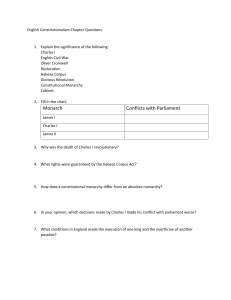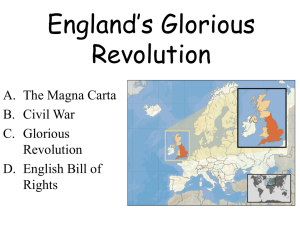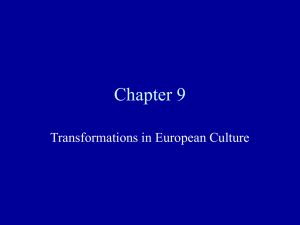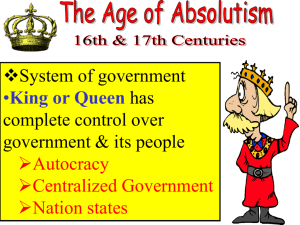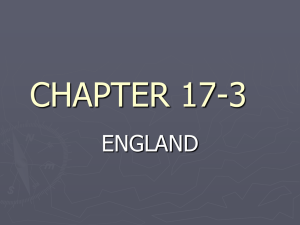Evolution of British Govt
advertisement
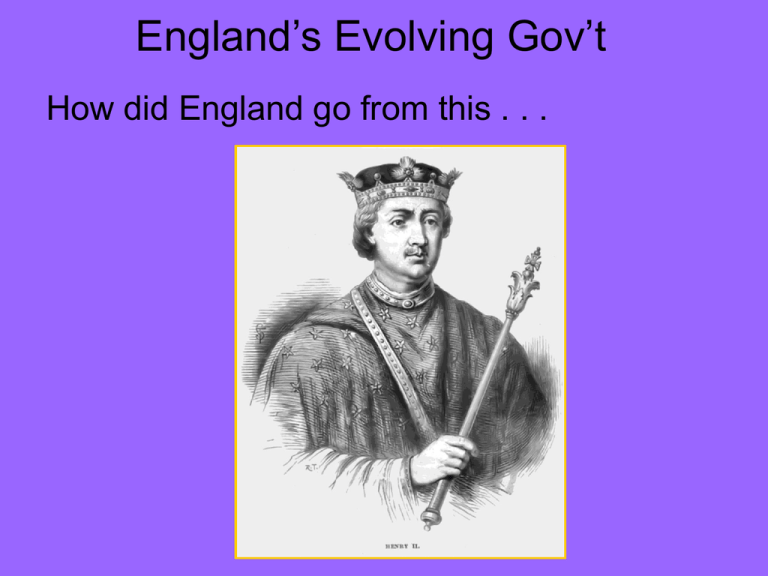
England’s Evolving Gov’t How did England go from this . . . To this . . . Prime Minister's Question Time Absolute Monarchy Constitutional Monarchy England has a long history of tension between absolutism and democracy Modern concepts of jury trials, common law, and legal rights developed during this history. The United States adopted many of the government reforms and institutions that the English developed during this period. Take out your British Government Note Packet 1215 – Nobles force King John to approve the Magna Carta (Great Charter). King’s will is bound by law. Guaranteed basic rights like jury trials, habeas corpus, no taxation without representation. 1295 – Edward I summons Model Parliament. Evolved into the House of Lords and House of Commons. John of England signs Magna Carta Magna Carta and the Rule of Law 1628 – Parliament forces Charles I to sign Petition of Right to limit royal authority: no arbitrary arrest; no taxes without Parliament; no quartering soldiers; no martial law in peacetime. 1642 – 49: English Civil War between supporters of Charles (Royalists) and Puritan supporters of Parliament (Parliamentarians). Called “Cavaliers” and “Roundheads” by their enemies. “Roundheads” wore their hair short Royalists or “Cavaliers” were more flamboyant 1644 - Oliver Cromwell becomes general on Puritan side. Defeats Cavaliers. 1649 - Charles faces trial and execution (“regicide”) Cromwell abolishes monarchy & House of Lords. England becomes a commonwealth (republican form of gov’t) In practice, Cromwell ruled as a military dictator (“Lord Protector of England”) Puritans abolish activities they find sinful (theater, dance, sports) Cromwell movie trailer 1658 – Cromwell dies; next year Parliament asks Charles’ son to rule Charles II 1660 – Restoration of monarchy under Charles II During reign, Parliament passes Habeas Corpus Act, law requiring king to charge prisoner with crime 1685 - Charles’s Catholic brother James II becomes king 1688 - Glorious Revolution, bloodless overthrow of James James II 1689 - Protestants William and Mary become joint sovereigns of England; agree to constitutional monarchy that limits royal power (not absolute monarchy) Parliament drafts Bill of Rights to limit royal power; monarchs consent: • No suspending of Parliament’s laws • No levying of taxes without Parliament’s approval • Freedom of speech in Parliament • Citizens may petition king about grievances William and Mary were always listed together since the royal bloodline was with Mary as James’ daughter. Only time in British history when there are co-monarchs. Guantanamo Bay Naval Base Military Commission Act of 2006 Stops Guantanamo detainees from access to the United States courts through a writ of habeas corpus. Detainees would have access to military tribunals. Habeas Corpus Restoration Act of 2007 Would have restored the right of Guantanamo detainees to access United States courts. The bill did not survive a Republican filibuster. Boumediene v. Bush (2008) In a 5 to 4 decision, the Supreme Court rules that the executive branch could not withhold access to the U.S. judicial system (civilian courts) from Guantanamo detainees. Justice Kennedy delivered the majority opinion. He began with an overtwenty page review of the history of habeas corpus in England from its roots in the due process clause of Magna Carta of 1215 to the nineteenth century. “Within the Constitution’s separation-of-powers structure, few exercises of judicial power are as legitimate or as necessary as the responsibility to hear challenges to the authority of the Executive to imprison a person. Some of these petitioners have been in custody for six years with no definitive judicial determination as to the legality of their detention.” Justice Scalia delivered a dissenting opinion: “The Constitution does not ensure habeas for aliens held by the United States in areas over which our Government is not sovereign. . . The Court’s decision will almost certainly cause more Americans to be killed.”
